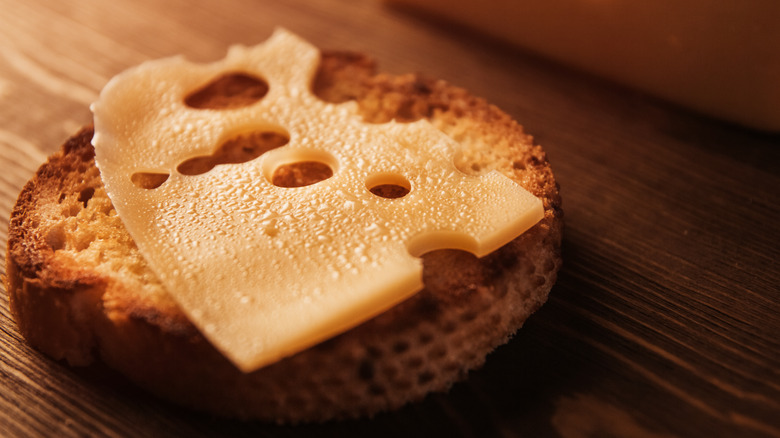Yes, Cheese Sweats Are A Thing — Here's Why It Happens
When serving an array of snacks, a big cheese board is always a crowd-pleasing option. Whether you're hosting a book club or movie night, you can't go wrong with baked brie or blue-marbled Roquefort paired with crackers, fruit, and cold cuts. A smorgasbord of rich, creamy cheeses is even the last course at many French dinner parties, allowing guests to cleanse their palates while closing out a pleasant evening in good company. But despite the many merits of the oh-so-glorious dairy product, there's one slightly unappetizing thing you should be wary of when setting out a board-full of the stuff: Cheese sweats, literally.
The term might call to mind the "meat sweats," but that's not the type of perspiration we're talking about. While some people really do sweat after eating cheese (and may be particularly sensitive to specific kinds) — a medical condition known as gustatory hyperhidrosis that's sometimes connected to nerve damage and conditions characterized by it, such as diabetes — cheese sweats often refer to the food itself sweating, so to speak. If you've ever noticed that slices of gouda or cheddar develop a slick coating after sitting out on a charcuterie board for a while, you were looking at sweaty cheese. Small beads of moisture can accumulate on the dairy product for a couple of reasons. Fortunately, though, while its sweatiness may give some cheese connoisseurs the ick, it isn't cause for concern from a safety standpoint and can still be prevented with a few changes to your serving strategies.
The science behind sweaty cheese
Put cheese and people in the same room at a party and you may notice some similarities. Once removed from its optimal environment (the consistently cool fridge) and put on display, the dairy product begins to break down. As it heats up, whether from bright lights or sitting in a stuffy room for too long, cheese starts to sweat. Of course, the change isn't from feelings of stress or fatigue, but because temperature affects its structural integrity, allowing moist fatty acids to escape.
After a lengthy process involving fermentation and coagulation, milk is turned into curds and whey, which are cut, flavored, pressed, and aged into delicious wheels of cheese. The resulting dairy product is composed of casein proteins, which trap fat, water, and sugar throughout interlocking chains. When left at room temperature for too long, these proteins — and the structure they form — start to come apart. Fat escapes to the surface, resulting in an oily sheen. Accordingly, the speed and severity of this sweaty cheese phenomenon is impacted by richness. High-fat types, including hard cheeses and sheep's milk cheeses like Manchego, for instance, are especially prone to sweating.
However, temperature isn't the only thing that can lead to wet cheese. How it's packaged also impacts moisture accumulation. While grocery stores package cheese in plastic, you shouldn't leave it tightly wrapped in the material. Give cheese some extra breathing room to prevent condensation from being trapped on its surface and potentially speeding up spoilage.
How to stop your cheese from sweating
If you're setting up a cheese board at a fancy party, you probably want it to look its best. However, keeping it cold until the last second might be good for aesthetics, but not so much for eating. Allowing the fat to warm and expand just enough draws out deeper, subtle flavors and aromas. Clearly, when trying to avoid sweaty cheese, you're walking a narrow Goldilocks-esque line in terms of temperature management.
For optimal taste, most types of cheese should be pulled from the fridge an hour before guests arrive, according to the Academy of Cheese. (Soft brie might need twice as much time, while fresh goat cheese is fine with only 30 minutes.) However, to limit sweating, wait to transfer cheese from its packaging to the serving platter. This also applies to slicing, which should be delayed to limit the surface area that can sweat.
Once the cheese hits the plate, the race against the clock starts. Obviously, the faster people eat it, the less time fat has to seep out of each piece. For fancy gatherings, staggering how often slices are put out can help prevent any cheese presentation faux pas related to pacing. At outdoor events, it's also important to be mindful of how hot weather might affect timing and may warrant keeping cheese indoors altogether. Worst case, if any wedges start looking a little too shiny, dab away any cheese sweat with a paper towel, easy peasy.


